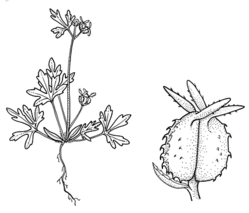Common name: Creeping Carrot
Trachymene ceratocarpa (W.Fitzg.) Keighery & Rye APNI* Synonyms: Uldinia ceratocarpa (W.Fitzg.) N.T.Burb. APNI*

Description: Decumbent to erect annual herb to 15 cm high, stems glabrous or rarely with scattered hairs.
Basal leaves circular-cordate, 7–21 mm long, palmately divided into 3 obovate-cuneate lobed segments, sometimes further divided into 2 or 3 secondary lobes; petiole 5–40 mm long; stem leaves smaller, less divided; glabrous or with a few scattered hairs.
Umbels 3–5-flowered; peduncle 5–10 mm long; bracts 4, lanceolate, c. 2 mm long, ± as long as flowers; pedicels very short. Flowers blue or white. Sepals absent. Petals ovate, imbricate, not inflexed at apex.
Fruit laterally compressed, circular, 3–4 mm long, 6-ribbed on each side; apical appendage 3–5 mm long, horizontally spreading.
Flowering: August–November
Distribution and occurrence: Naturalised on red sandy soils west and north from Cobar.
NSW subdivisions: NWP, NFWP
Formerly in Apiaceae.
Text by J. M. Powell, except for genera with authors listed; Updated Louisa Murray Sept 2014.
Taxon concept: as under Uldinia ceratocarpa in Flora of NSW 3 (1992); Keighery and Rye (1999) A taxonomic Revision of Tracymene sect. Dimetopia (Apiaceae). Nuystia 13(1):33-59.
APNI* Provides a link to the Australian Plant Name Index (hosted by the Australian National Botanic Gardens) for comprehensive bibliographic data
***The AVH map option provides a detailed interactive Australia wide distribution map drawn from collections held by all major Australian herbaria participating in the Australian Virtual Herbarium project.
|


